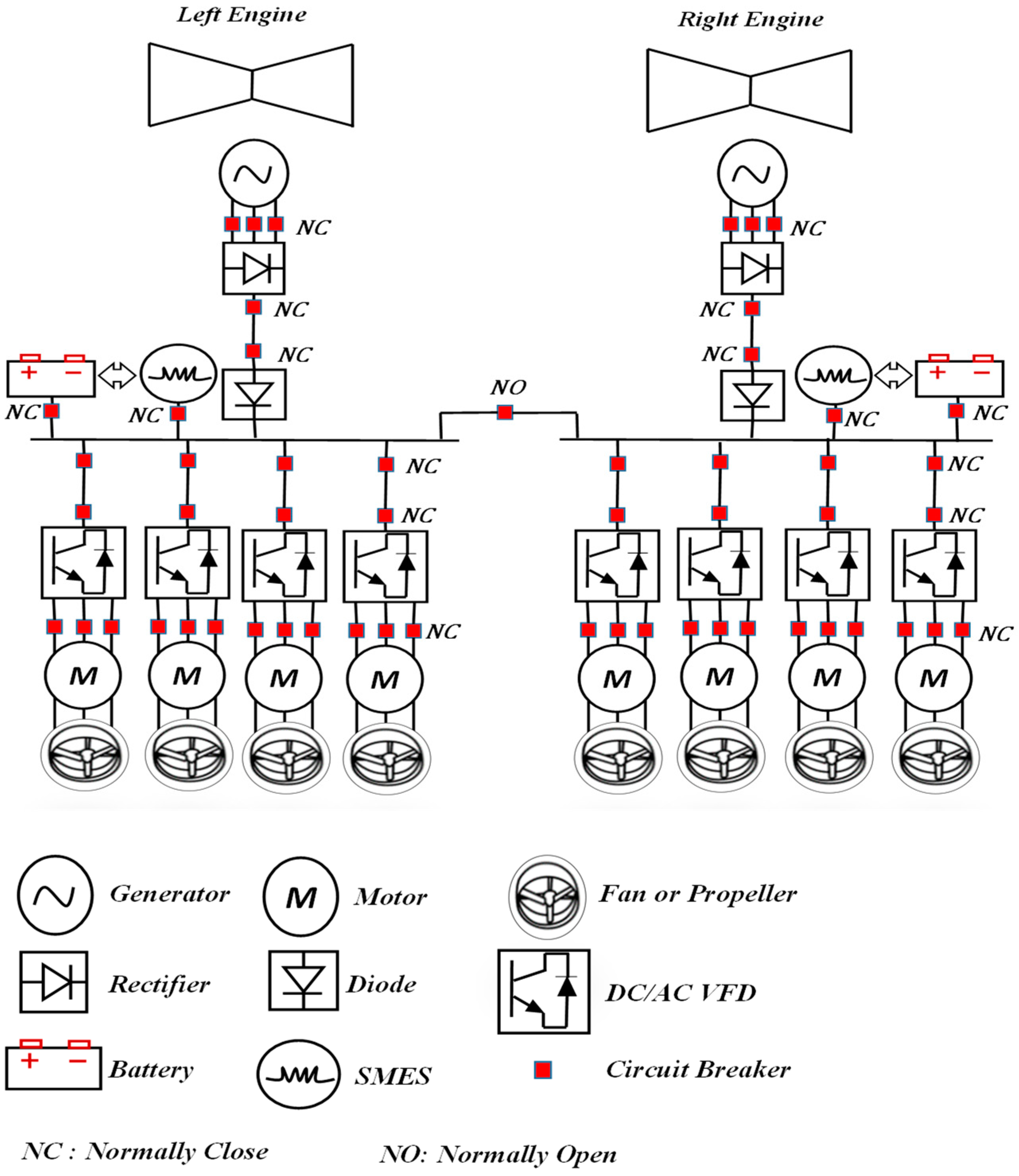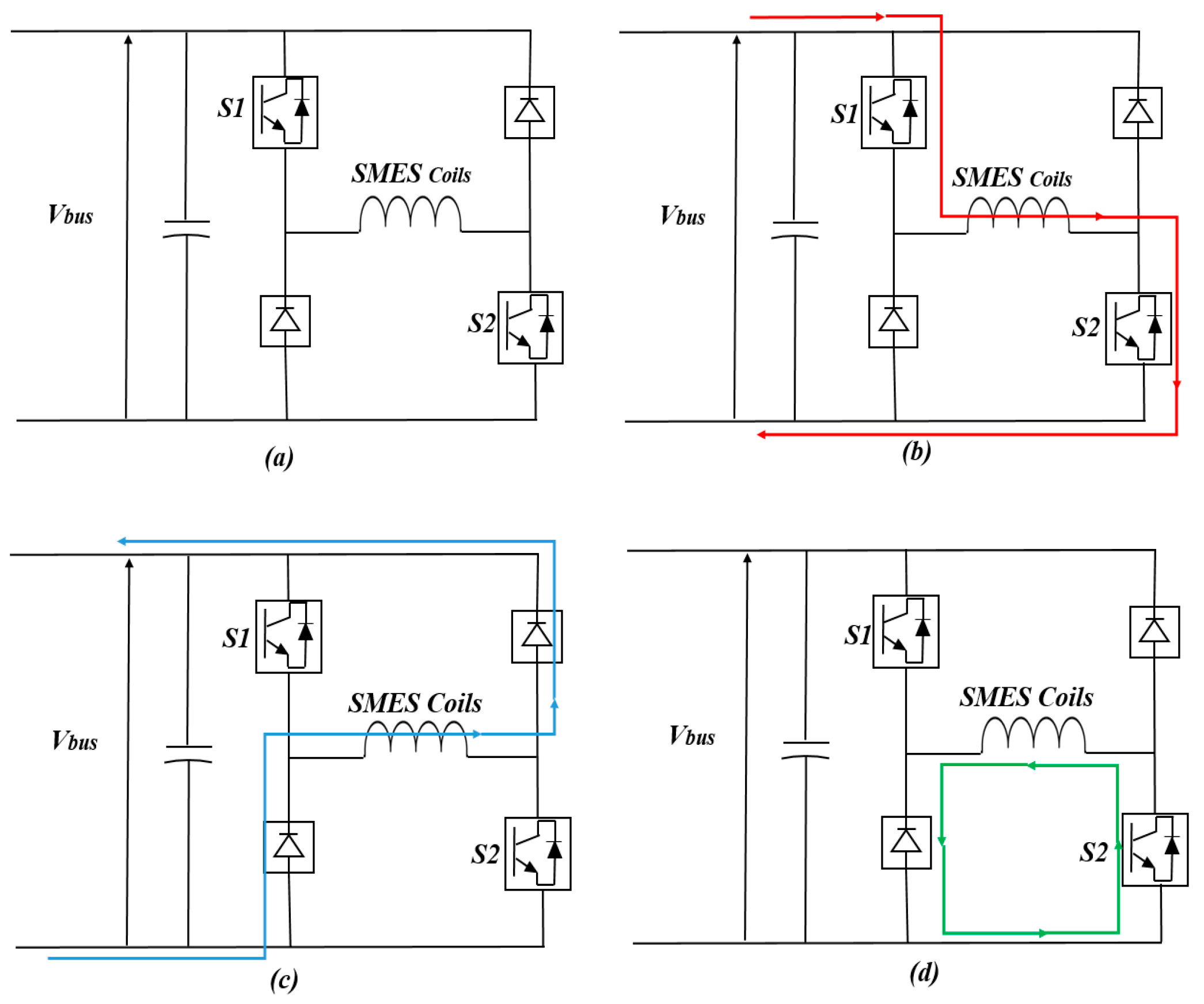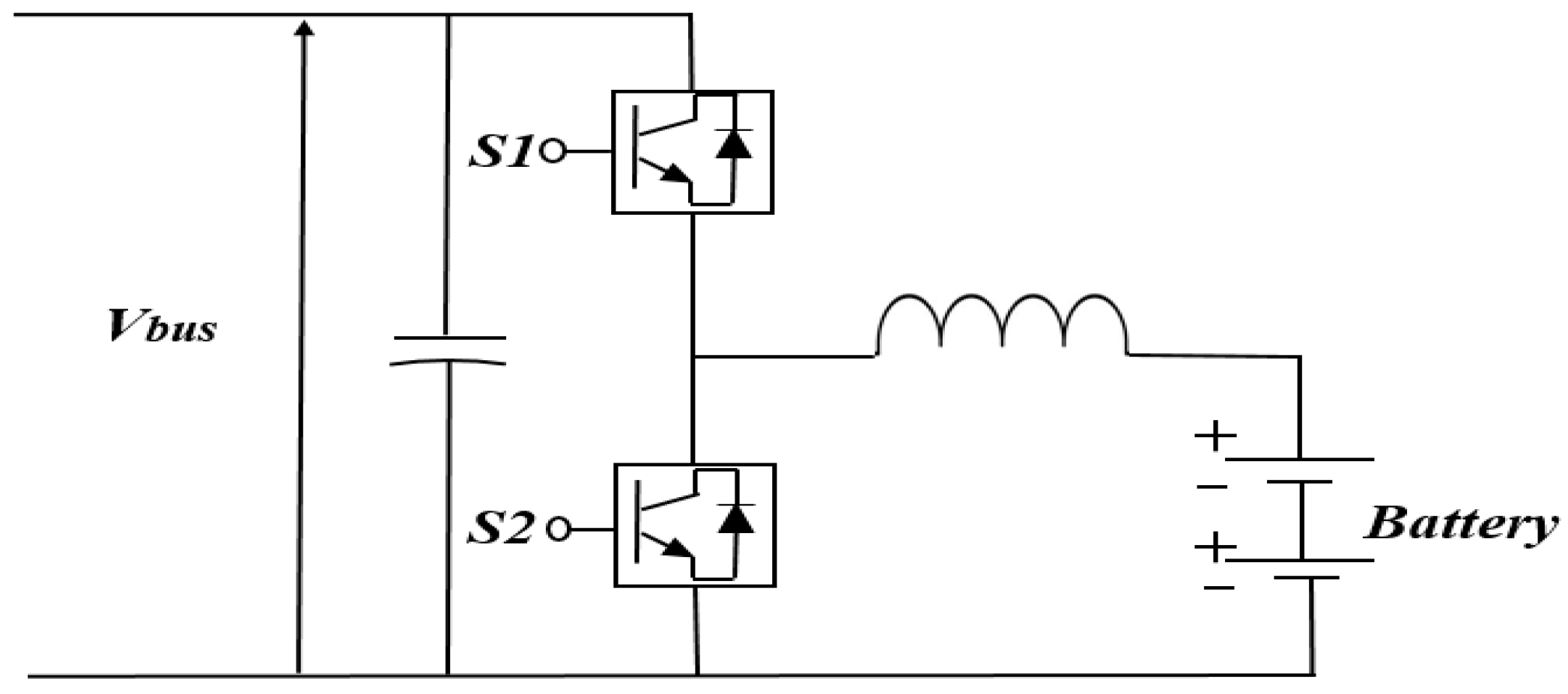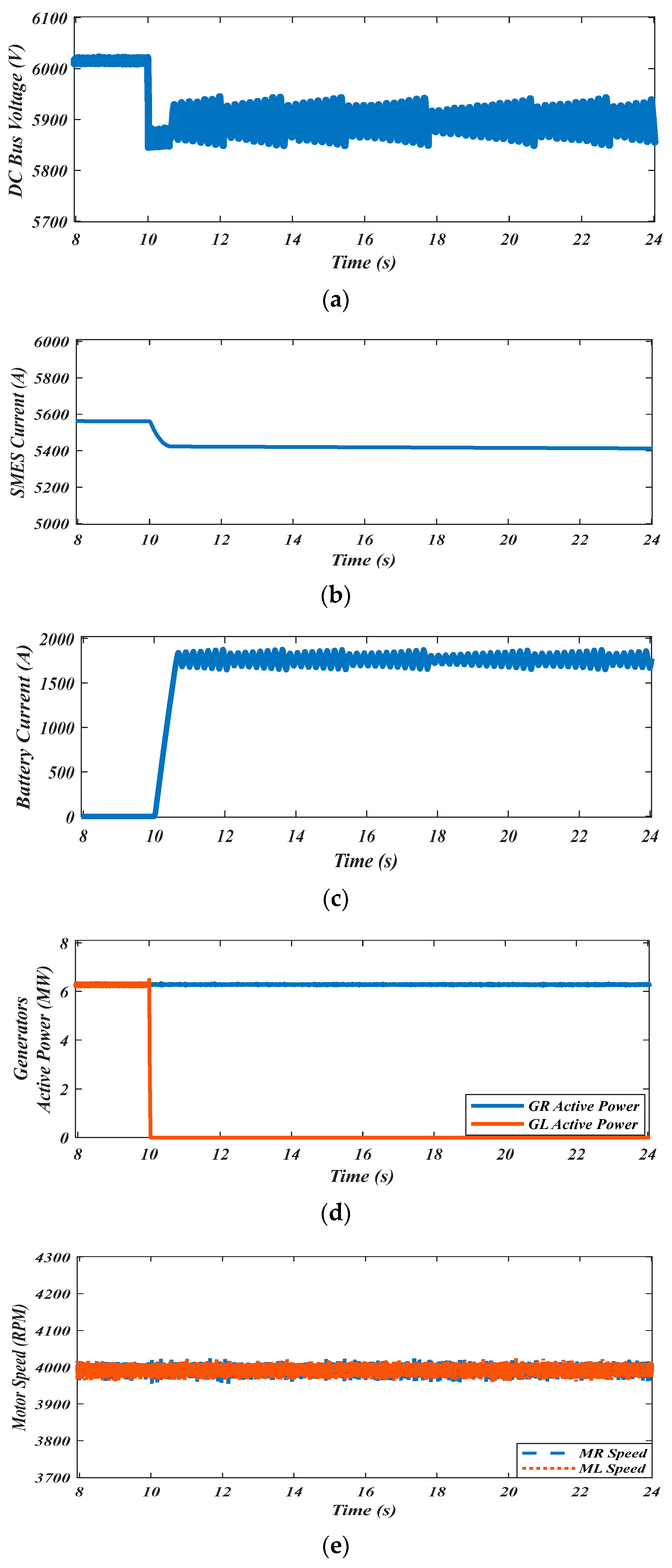The Possibility of Using Superconducting Magnetic Energy Storage/Battery Hybrid Energy Storage Systems Instead of Generators as Backup Power Sources for Electric Aircraft
Abstract
:1. Introduction
1.1. Background and Motivation
1.2. Literature Review
1.3. Contribution
2. Model Analysis
2.1. Generator–Backup-Generator (GBG) System
2.2. Battery–Backup-Generator (BBG) System
3. System Description
3.1. Electric Propulsion Motor
3.2. Superconducting Magnetic Energy Storage (SMES)
3.3. Battery Bank (Lithium Ion)
4. Energy Storage Control Method
4.1. Generator–Backup-Generator Design Control
- (Vbus < Vref(min)) Discharge mode
- 2.
- (Vref(max) > Vbus > Vref(min)) Standby mode
- 3.
- (Vbus > Vref(max)) Charge mode
4.2. Battery–Backup-Generator Design Control
5. Simulation Results
5.1. Generator–Backup-Generator Simulation Results
5.2. Battery–Backup-Generator Simulation Results
6. System Sizing Study
7. Conclusions
Author Contributions
Funding
Institutional Review Board Statement
Informed Consent Statement
Data Availability Statement
Conflicts of Interest
References
- United States Environmental Protection Agency (EPA). Sources of Greenhouse Gas Emissions. 2020. Available online: https://www.epa.gov/ghgemissions/sources-greenhouse-gas-emissions (accessed on 6 September 2022).
- ICAO. Medium-Term Passenger and Freight Traffic Forecasts. 2013. Available online: https://www.icao.int/sustainability/pages/eap_fp_forecastmed.aspx (accessed on 6 September 2022).
- Suder, K.L. Overview of the NASA Environmentally Responsible Aviation Project’s Propulsion Technology Portfolio. In Proceedings of the 48th AIAA/ASME/SAE/ASEE Joint Propulsion Conference & Exhibit, Atlanta, Georgia, 30 July–1 August 2012; pp. 1–23. [Google Scholar] [CrossRef] [Green Version]
- ACARE. Strategic research & innovatino agenda. Development 2017, 1, 26–28. [Google Scholar] [CrossRef]
- Epstein, A.H. Aeropropulsion for commercial aviation in the twenty-first century and research directions needed. AIAA J. 2014, 52, 901–911. [Google Scholar] [CrossRef]
- Airbus Group. “E-Fan: The New Way to Fly”, Brochure. 2015. Available online: http://company.airbus.com/service/mediacenter/download/?uuid=48b1bd2c-a428-4c65-82e5-ed3e923bd142 (accessed on 7 September 2022).
- Eviation. Eviation Alice. 2022. Available online: https://www.eviation.com/aircraft/ (accessed on 14 September 2022).
- Berg, F.; Palmer, J.; Miller, P.; Husband, M.; Dodds, G. HTS Electrical System for a Distributed Propulsion Aircraft. IEEE Trans. Appl. Supercond. 2015, 25, 1–5. [Google Scholar] [CrossRef]
- Armstrong, M.J.; Blackwelder, M.; Bollman, A.; Ross, C.; Campbell, A.; Jones, C.; Norman, P. Architecture, Voltage, and Components for a Turboelectric Distributed Propulsion Electric Grid. 2015; pp. 1–270. Available online: https://ntrs.nasa.gov/search.jsp?R=20150014237 (accessed on 14 September 2022).
- Mukherjee, P.; V Rao, V. Design and development of high temperature superconducting magnetic energy storage for power applications—A review. Phys. C Supercond. Its Appl. 2019, 563, 67–73. [Google Scholar] [CrossRef]
- Hasan, N.S.; Hassan, M.Y.; Majid, M.S.; Rahman, H.A. Review of storage schemes for wind energy systems. Renew. Sustain. Energy Rev. 2013, 21, 237–247. [Google Scholar] [CrossRef]
- Farhadi, M.; Mohammed, O. Energy storage technologies for high-power applications. IEEE Trans. Ind. Appl. 2016, 52, 1953–1962. [Google Scholar] [CrossRef]
- Uranga, A.; Drela, M.; Hall, D.K.; Greitzer, E.M. Analysis of the aerodynamic benefit from boundary layer ingestion for transport aircraft. AIAA J. 2018, 56, 4271–4281. [Google Scholar] [CrossRef]
- Armstrong, M.J.; Ross, C.A.H.; Blackwelder, M.J.; Rajashekara, K. Propulsion system component considerations for NASA N3-X turboelectric distributed propulsion system. SAE Int. J. Aerosp. 2012, 5, 344. [Google Scholar] [CrossRef]
- Armstrong, M.J.; Ross, C.A.H.; Blackwelder, M.J. Trade studies for NASA N3-X turboelectric distributed propulsion system electrical power system architecture. SAE Int. J. Aerosp. 2012, 5, 325–336. [Google Scholar] [CrossRef]
- Ybanez, L.; Colle, A.; Nilsson, E.; Berg, F.; Galla, G.; Tassisto, M.; Rivenc, J.; Kapaun, F.; Steiner, G. ASCEND: The first step towards cryogenic electric propulsion. IOP Conf. Series: Mater. Sci. Eng. 2022, 1241, 012034. [Google Scholar] [CrossRef]
- Airbus Press Release. Airbus to Boost ‘Cold’ Technology Testing as Part of Its Decarbonisation Roadmap. Airbus Newsroom, no. March, 2021. Available online: https://www.airbus.com/en/newsroom/press-releases/2021-03-airbus-to-boost-cold-technology-testing-as-part-of-its (accessed on 25 September 2022).
- Alafnan, H.; Zhang, M.; Yuan, W.; Zhu, J.; Li, J.; Elshiekh, M.; Li, X. Stability Improvement of DC Power Systems in an All-Electric Ship Using Hybrid SMES/Battery. IEEE Trans. Appl. Supercond. 2018, 28, 1–6. [Google Scholar] [CrossRef] [Green Version]
- Van Vu, T.; Gonsoulin, D.; Diaz, F.; Edrington, C.S.; El-Mezyani, T. Predictive control for energy management in ship power systems under high-power ramp rate loads. IEEE Trans. Energy Convers. 2017, 32, 788–797. [Google Scholar] [CrossRef]
- Haran, K.S.; Kalsi, S.; Arndt, T.; Karmaker, H.; Badcock, R.; Buckley, B.; Haugan, T.; Izumi, M.; Loder, D.; Bray, J.W.; et al. High power density superconducting rotating machines—Development status and technology roadmap. Supercond. Sci. Technol. 2017, 30, 123002. [Google Scholar] [CrossRef]
- Chin, K.B.; Brandon, E.J.; Bugga, R.V.; Smart, M.C.; Jones, S.C.; Krause, F.C.; West, W.C.; Bolotin, G.G. Energy Storage Technologies for Small Satellite Applications. Proc. IEEE 2018, 106, 419–428. [Google Scholar] [CrossRef]
- Elsherbiny, H.; Szamel, L.; Ahmed, M.K.; Elwany, M.A. High accuracy modeling of permanent magnet synchronous motors using finite element analysis. Mathematics 2022, 10, 3880. [Google Scholar] [CrossRef]
- Trevisani, L.; Morandi, A.; Negrini, F.; Ribani, P.L.; Fabbri, M. Cryogenic fuel-cooled SMES for hybrid vehicle application. IEEE Trans. Appl. Supercond. 2009, 19, 2008–2011. [Google Scholar] [CrossRef]
- Khedr, M.; Zeng, X.; Pei, X. Design of a bidirectional DC/DC converter for energy storage in electric aircraft. In Proceedings of the 2021 IEEE Design Methodologies Conference (DMC), Bath, UK, 14–15 July 2021; pp. 1–6. [Google Scholar] [CrossRef]
- Choi, J.-Y.; Choi, I.-S.; Ahn, G.-H.; Won, D.-J. Advanced power sharing method to improve the energy efficiency of multiple battery energy storages system. IEEE Trans. Smart Grid 2016, 9, 1292–1300. [Google Scholar] [CrossRef]
- Gemin, P.; Kupiszewski, T.; Radun, A.; Pan, Y.; Lai, R.; Zhang, D.; Wang, R.; Wu, X.; Jiang, Y.; Galioto, S.; et al. Architecture, Voltage and Components for a Turboelectric Distributed Propulsion Electric Grid (AVC-TeDP). 2015; Volume 1, pp. 1–107. Available online: https://ntrs.nasa.gov/api/citations/20150014583/downloads/20150014583.pdf (accessed on 29 September 2022).
- IEEE Std. 1709–2010; IEEE Recommended Practice for 1 kV to 35 kV Medium-Voltage DC Power Systems on Ships, no. November. IEEE: Piscataway Township, NJ, USA, 2010. [CrossRef]








Disclaimer/Publisher’s Note: The statements, opinions and data contained in all publications are solely those of the individual author(s) and contributor(s) and not of MDPI and/or the editor(s). MDPI and/or the editor(s) disclaim responsibility for any injury to people or property resulting from any ideas, methods, instructions or products referred to in the content. |
© 2023 by the authors. Licensee MDPI, Basel, Switzerland. This article is an open access article distributed under the terms and conditions of the Creative Commons Attribution (CC BY) license (https://creativecommons.org/licenses/by/4.0/).
Share and Cite
Alafnan, H.; Pei, X.; Khedr, M.; Alsaleh, I.; Albaker, A.; Alturki, M.; Mansour, D.-E.A. The Possibility of Using Superconducting Magnetic Energy Storage/Battery Hybrid Energy Storage Systems Instead of Generators as Backup Power Sources for Electric Aircraft. Sustainability 2023, 15, 1806. https://doi.org/10.3390/su15031806
Alafnan H, Pei X, Khedr M, Alsaleh I, Albaker A, Alturki M, Mansour D-EA. The Possibility of Using Superconducting Magnetic Energy Storage/Battery Hybrid Energy Storage Systems Instead of Generators as Backup Power Sources for Electric Aircraft. Sustainability. 2023; 15(3):1806. https://doi.org/10.3390/su15031806
Chicago/Turabian StyleAlafnan, Hamoud, Xiaoze Pei, Moanis Khedr, Ibrahim Alsaleh, Abdullah Albaker, Mansoor Alturki, and Diaa-Eldin A. Mansour. 2023. "The Possibility of Using Superconducting Magnetic Energy Storage/Battery Hybrid Energy Storage Systems Instead of Generators as Backup Power Sources for Electric Aircraft" Sustainability 15, no. 3: 1806. https://doi.org/10.3390/su15031806
APA StyleAlafnan, H., Pei, X., Khedr, M., Alsaleh, I., Albaker, A., Alturki, M., & Mansour, D.-E. A. (2023). The Possibility of Using Superconducting Magnetic Energy Storage/Battery Hybrid Energy Storage Systems Instead of Generators as Backup Power Sources for Electric Aircraft. Sustainability, 15(3), 1806. https://doi.org/10.3390/su15031806







